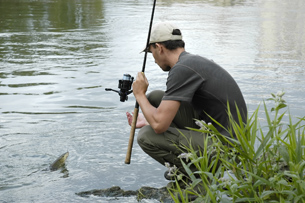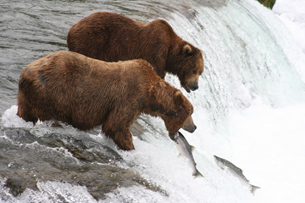Module 8
1. Module 8
1.20. Lesson 5
Module 8—Populations, Individuals, and Gene Pools
Lesson 5: Species Interactions and Symbiotic Relationships
 Get Focused
Get Focused


left: © Pavol Kmeto/2741524/Fotolia; right: © Red/5164739/Fotolia
If you had to compete against your friends to find food in the wild, how do you think you would do? Which of your phenotypes, and therefore alleles, would give you the advantage? As food became more scarce, would the selection for those alleles become stronger or weaker? Often, the ability to survive competition within a species is due to several phenotypes acting together to make a more fit individual. This could include a combination of better eyesight, faster reflexes, and the intelligence to learn from previous mistakes—to say nothing of patience. What if you had to compete against another predator species for the same food? Could you catch more fish than a bear? Could you defend yourself from a bear just to get the opportunity to fish? If no predators were present, would the fish population suffer in any way from the absence of predators?
This lesson will look at the relationships that exist between individuals of different species. Some relationships are positive for both species. In other relationships between species, the outcome is fatal for one individual. In most cases, the result can be positive for that individual’s population as a whole.
In this lesson the following focusing questions will be examined:
- What relationships exist between species and ecosystems?
- What effect do these interactions have on population changes?
 Module 8: Lesson 5 Assignment
Module 8: Lesson 5 Assignment
Download a copy of the Module 8: Lesson 5 Assignment to your computer now. You will receive further instructions on how to complete this assignment later in the lesson.
In addition to your lesson work, any summary notes, diagrams, charts, or tables should be stored in the course folder for your teacher’s feedback and study as you prepare for exams.
The other questions in this lesson are not marked by the teacher; however, you should still answer these questions. The Self-Check and Try This questions are placed in this lesson to help you review important information and build key concepts that may be applied in future lessons.
After a discussion with your teacher, you must decide what to do with the questions that are not part of your assignment. For example, you may decide to submit to your teacher the responses to Try This questions that are not marked. You should record the answers to all of the questions in this lesson and place those answers in your course folder.
Remember, you also have the option of trying additional questions from the textbook for further practice. Consult with your teacher for the answers to these questions. The Key will also provide you with many diploma exam-style multiple-choice, numerical-response, and written-response questions that will be an excellent review of the module. Practising your responses to these types of questions is good preparation for the Diploma Exam.